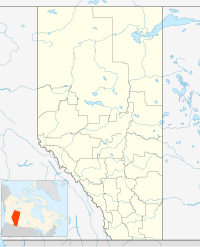Paul Band
| Paul First Nation | |
|---|---|
| Indian reserve | |
| Location of Paul First Nation in Alberta | |
| Coordinates: 53°52′N 114°50′W / 53.867°N 114.833°WCoordinates: 53°52′N 114°50′W / 53.867°N 114.833°W | |
| Country | Canada |
| Province | Alberta |
| Region | Edmonton Capital Region |
| Census division | 11 |
| Municipal district | Parkland County |
| Wabamum Lake Indian Reserve | 1891 |
| Government | |
| • Chief | Casey Bird |
| • Governing body | Paul First Nation |
| Lowest elevation | 0 m (0 ft) |
| Population (2011) | |
| • Total | 1,000 |
| Time zone | MST (UTC-7) |
| Website | Official website |
|
Postal code span: PO Box 89, Duffield, Alberta T0E 0N0 |
|
Postal code span: PO Box 89, Duffield, Alberta
The Paul First Nation, more commonly known as the Paul Band, is a First Nations band government based in Wabamun, Alberta of mixed Cree and Nakoda (Stoney) origin. They are party to Treaty Six and had the Buck Lake Indian Reserve 133C and Wabamun Lake Indian Reserve 133A, 133B and 133C allocated to them by the federal government in 1892. However the Buck Lake Reserve was decimated by the Spanish Flu of 1918 and is now largely abandoned.
As of 2005, the nation had 1,926 members, of which 1,110 lived on-reserve.
Paul Band's Wabamun 133A and 133B lands are located along Lake Wabumun, approximately 70 km (43 mi) west of Edmonton. The lake is a popular destination for Alberta to spend weekends and holidays, and the band operates the Ironhead Golf and Country Club to appeal to this market.
In April 2010 there was a devastating costly wild fire that caused community members to flee.
The Paul Band signed a treaty in 1876 and settled on the eastern edge of Lake Wabamun. While the total population of the Paul Band was 1397, 856 individuals were living on the Paul Band Reserve in 1996. By 1998 there were 1,400 members of the Paul First Nation. The majority were Stoney and the remainder Cree. In Alberta the Nakoda were known as Stoney. They were also grouped by the Cree term Assiniboine. They all speak common Siouan language but according to Bird, "there are differences in dialects spoken between the groups in Alberta and also between those in Alberta and those in Saskatchewan and Montana."
The Stoney are descendants of individual bands of Dakota, Lakota and Nakota, in particular of western groups of Assiniboine, from which they spun out as an independent group at about 1744. The Stoney were divided geographically and culturally into two tribal groups or divisions with different dialects, which in turn were further divided into several bands:
...
Wikipedia

